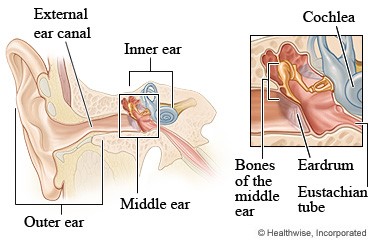Bone-Anchored Hearing Systems
What you need to know

What is a bone-anchored hearing system?
A bone-anchored hearing system includes both a bone-conduction hearing aid and an implant in the skull. The hearing aid is connected to the implant. The hearing aid picks up sounds from the environment, which are then transmitted to the inner ear by sending vibrations through the skull.
The ear is made up of the external ear canal, the middle ear, and the inner ear. The middle ear is separated from the ear canal by the eardrum. The inner ear contains the cochlea, which is the main organ of hearing.
Typically, sound waves enter the ear canal and strike the eardrum. The bones of the middle ear vibrate, sending sound waves to the inner ear. There, the cochlea changes sound waves into electrical signals, which are sent to the brain. The brain interprets these signals as sound.
A bone-anchored hearing system can be helpful when there is a problem with the outer or middle ear. The system bypasses the outer and middle ear by sending sound waves or vibrations through the skull directly to the cochlea.
A bone-anchored hearing system might be an option for you if:
- You were born without an ear canal or with an underdeveloped outer ear. This is called congenital aural atresia or aural microtia.
- You have chronic outer or middle ear infections, and placing a conventional hearing aid into the ear canal could make these infections worse.
- You have a history of ear surgery (like mastoidectomy), especially if your ear is routinely draining fluid.
- You have a profound hearing loss on only one side.
If you think that a bone-conduction hearing system might be an option for you or your child, talk with your audiologist (hearing specialist) or doctor. They can refer you to the appropriate specialized program.
How is this system attached?
A titanium implant is placed into the skull bone behind the ear. This requires minor surgery.
There are different ways of connecting a bone-conduction hearing aid (the sound processor) to the implant. The hearing aid can clip onto an extension of the implant called an abutment. It can also connect to the implant with a magnet.
All of the pieces sit behind the ear. No part of the system is within the ear itself.
If surgery is not an option, or for children under 5 years old, the bone-conduction hearing aid can also be worn on a soft headband, without an implant.
What can you expect when you have a bone-anchored hearing system?
Your doctor will tell you how to care for the site of the implant.
Your audiologist will program the hearing aid based on your individual hearing loss. You can expect to have several follow-up visits with your audiologist to fine-tune the hearing aid.
To see this information online and learn more, visit https://MyHealth.Alberta.ca/health/aftercareinformation/pages/conditions.aspx?hwid=custom.ab_bone_anchored_hearing_systems_inst.

For 24/7 nurse advice and general health information call Health Link at 811.
Current as of: May 16, 2023
Author: Audiology Provincial Professional Practice, Alberta Health Services
This material is not a substitute for the advice of a qualified health professional. This material is intended for general information only and is provided on an "as is", "where is" basis. Although reasonable efforts were made to confirm the accuracy of the information, Alberta Health Services does not make any representation or warranty, express, implied or statutory, as to the accuracy, reliability, completeness, applicability or fitness for a particular purpose of such information. Alberta Health Services expressly disclaims all liability for the use of these materials, and for any claims, actions, demands or suits arising from such use.
